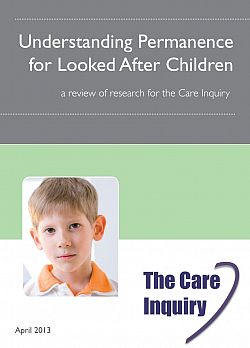High quality the key for children in care, says Sussex academic
What matters most for children in care is the quality and stability of their placements and relationships, says a University of Sussex academic who has contributed to a national investigation into how best to provide stable and permanent homes for these children.

 A new report by Dr Janet Boddy, Reader in Child, Youth & Family Studies at Sussex and Co-Director of the Centre for Innovation and Research in Childhood and Youth (CIRCY), examines what the research evidence can tell us about “permanence” for children in care.
A new report by Dr Janet Boddy, Reader in Child, Youth & Family Studies at Sussex and Co-Director of the Centre for Innovation and Research in Childhood and Youth (CIRCY), examines what the research evidence can tell us about “permanence” for children in care.
Dr Boddy was commissioned to prepare the briefing paper by the Care Inquiry. Established in 2012, the Inquiry is a collaboration between eight specialist charities involved in fostering, adoption and residential care and with families of children in care, supported by the Nuffield Foundation.
Dr Boddy presented her paper to the first evidence-gathering session of the Care Inquiry in November 2012 and her review – a reflective discussion of key research evidence - was published with the launch of the Inquiry's final report in the House of Commons on Tuesday (30 April).
The Care Inquiry’s main overall conclusion – drawing on Dr Boddy’s review of the research evidence as well as other submissions and consultation exercises – is that “permanence” for children who cannot live with their birth parents (whether permanently or temporarily) means “security, stability, love and a strong sense of identity and belonging”.
This is not necessarily connected to legal status, says the Care Inquiry; adoption, although right for some children, will only ever provide permanence for a small number of children in care.
There can be a variety of routes to permanence for children in care, including:
- permanent return to birth parents;
- arrangements for shared care, including regular short breaks;
- permanence within the care system, whether in a residential placement, a placement with unrelated foster carers or with family and friends; and
- legal permanence, through adoption, special guardianship and residence orders.
Dr Boddy’s review of the research suggests “the need for a broader and better differentiated understanding of permanence than is apparent within current policy discourses in relation to looked after children [i.e. children in care]: an understanding that goes beyond legal permanence”.
She says: “There are constraints on the supply of placements that can offer legal permanence, and legally permanent solutions are not appropriate for all children.
“To provide individual solutions, we not only need to support routes to legal permanence, but to place equal value on other ways of achieving permanence, including support for children and families at the ‘edges of care’ … as well as through permanent return to birth parents and permanence in shared or full-time care.”
What is critical, argues Dr Boddy, is that all options that are considered aim “to provide high-quality and stable care; supporting children’s sense of identity and belonging; and connecting past, present and future through childhood and transitions out of care, and on into adult life”.
